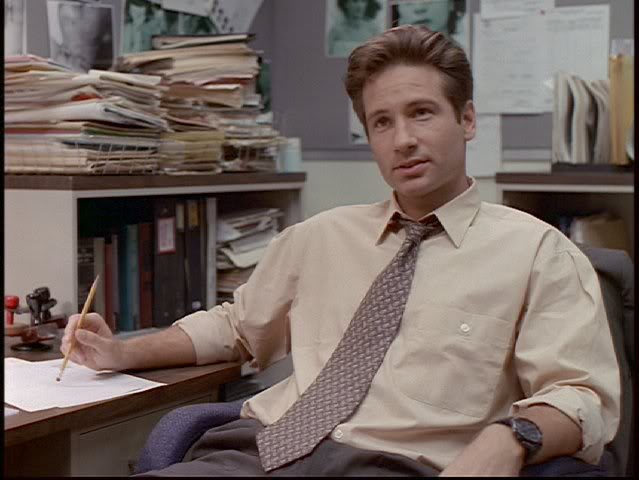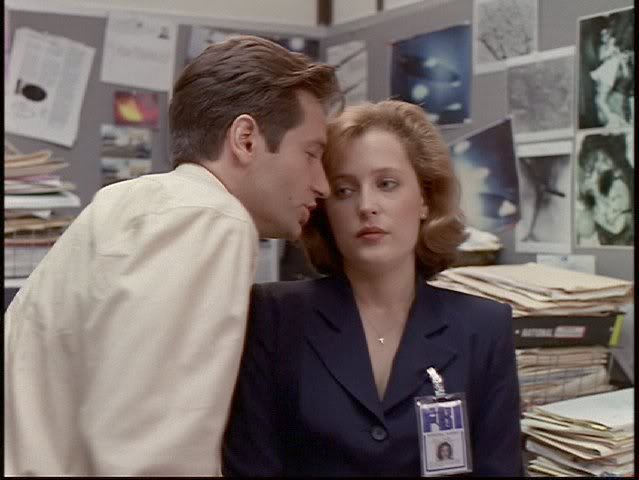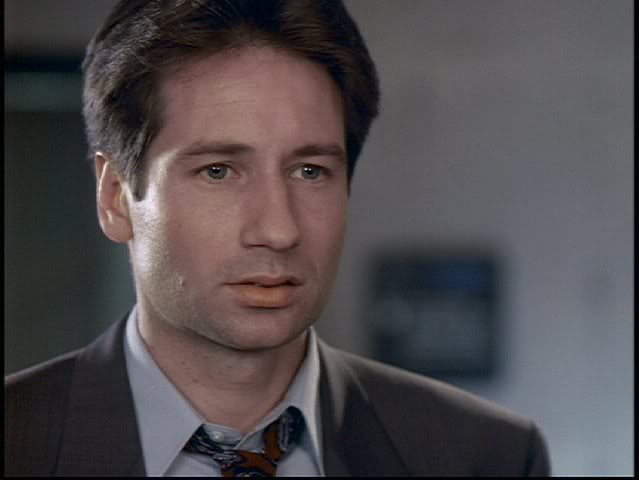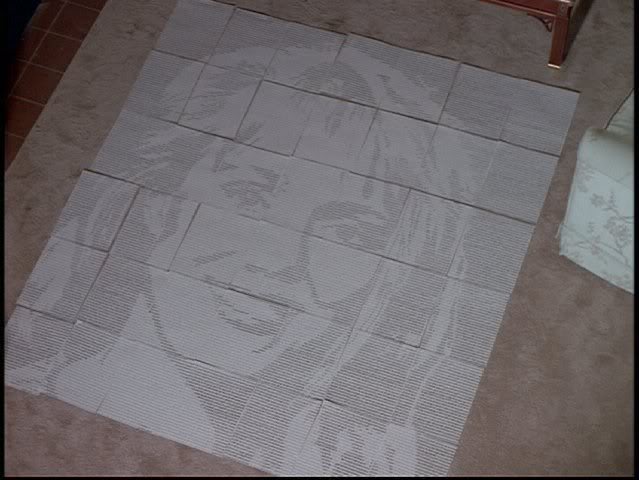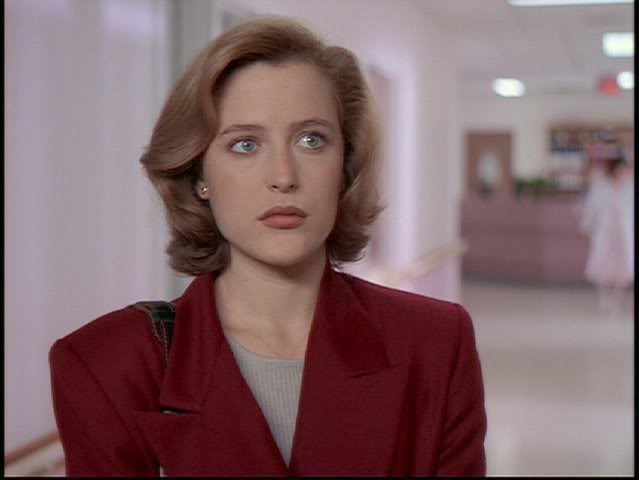REPOST -- CTP Episode of the Day - 04.04.06 - Conduit
Today's Cherished Episode: Conduit (1x03)
Original Air Date: October 1, 1993
Written By: Alex Gansa and Howard Gordon
Directed By: Daniel SackheimA teenage girl is abducted by aliens, compelling Mulder to confront feelings about his own sister's disappearance.
"Mulder stop. Stop running after your sister. This won't bring her back." "Come with me or don't come with me, but until they find a body, I'm not giving up on that girl."
Some "Conduit" Tidbits & Musings:
-- Title: A conduit is "a means of transmitting or distributing." As Mulder said in the episode, he believed the boy was a conduit -- a link or connection to whoever or whatever took the boy's sister.
-- Timeline: On their first day in Iowa, Mulder sent a fax dated August 26, 1993.
-- "Conduit" was only the fourth episode aired but the second directed by Daniel Sackheim. He also directed "The Host," "Kitsunegari," and "S.R. 819," served as a consulting producer for the series at various times, and was a producer of The X-Files movie.
-- "Conduit" grew from an initial idea of Chris Carter's that was then expanded upon by the writing team of Howard Gordon and Alex Gansa.
-- "The alien abduction story line in some of our episodes could be seen as a metaphor for incidents of abuse," said Howard Gordon, "because if you look at the governing symbols, they often involve violation and helplessness. The victimization is often of a sexual nature ... I think we often feel helpless in this society. It's getting more and more difficult to acknowledge our helplessness, and I think FBI Agents Mulder and Scully were the champions of that."
-- Samantha Mulder's file listed her home address as 2790 Vine Street, which was the former address of the X-Files production office in Vancouver.
-- In "Conduit," Samantha's file showed her middle initial to be "T" and her birthday to be 1/22/1964. However, in Season 3's "Paper Clip," her middle name was shown as "Ann" and her birth date was shown as 11/21/1965.
-- "Conduit" revealed Mulder's hometown to be Chilmarc, Massachusetts, though the spelling was "Chilmark" when the information turned up nearly a year later in Season 2's "Little Green Men." Chilmark (the correct spelling) is a town located on Martha's Vineyard in Dukes County, Massachusetts. The fishing village of Menemsha is located on the northern end of town along its border with the neighboring town of Aquinnah. In 2004, Chilmark was reported to have the highest average property value of any city or town in Massachusetts.
-- West Okoboji Lake, East Okoboji Lake, and Spirit Lake (the largest of the three) are a group of natural glacial lakes in northwestern Iowa referred to as the Iowa Great Lakes. They are the largest natural lakes in the state of Iowa. The spelling of Lake Okobogee used in the episode may be close to the way Okoboji was spelled when translated from the original Native Americans who first inhabited the area. Although there is no evidence that the Okoboji Lakes are "UFO hotspots" as Mulder indicated in the episode, the region is a popular destination for fisherman, both in summer and winter, as well as one of Iowa's most popular vacation destinations.
-- Mulder referred to the adult leader of the Girl Scout troop as a "den mother," but den mothers are in charge of Cub Scout troops. Adults in the Girl Scouts are simply referred to as "troop leaders" or "scout leaders." (Of course, why would an Indian Guide know that?)
-- The organization that Mulder mentioned to Darlene Morris -- the Center for U.F.O. Studies (CUFOS) -- is a privately-funded UFO research group. It was founded in 1973 by Dr. J. Allen Hynek, a professor of astronomy at Northwestern University in Evanston, Illinois, a suburb of Chicago. Dr. Hynek was also a top scientific consultant for Project Blue Book, the U.S. Air Force's official study of the UFO mystery from 1948 to 1969. Although Dr. Hynek started out as a skeptic and helped the Air Force to debunk most UFO reports, he gradually became convinced that a small number of UFO cases were not hoaxes or explainable as misidentifications of natural phenomena, and that these cases might represent something extraordinary, even alien visitations from other planets. When the Air Force shut down Project Blue Book in 1969, Dr. Hynek decided to establish his own organization to continue to study UFO reports in a scientific and unbiased manner. Hynek served as technical advisor for Steven Spielberg's Close Encounters of the Third Kind.
-- Based in Chicago, CUFOS continues to be a small research organization stressing scientific analysis of UFO cases. Its extensive archives include historically valuable files from defunct civilian research groups such as NICAP, one of the most popular and credible UFO research groups of the 1950s and 1960s. Following Dr. Hynek's death in 1986, CUFOS was renamed the J. Allen Hynek Center for UFO Studies in his honor.
-- Kevin Morris receiving messages through his TV set was a slight homage to the 1982 horror/thriller movie Poltergeist.
-- The first "Danny" reference! Mulder faxed a page of Kevin's ones and zeroes to "Danny Bernstein," Cryptology Section, at the FBI, who agreed to check it out in exchange for tickets to a Washington Redskins game. Mulder (and later Scully and even Doggett) contacted the mysterious and never-seen "Danny" for help with tracking down license plates, adoption record searches, and other miscellaneous information. (In "Aubrey," Danny's last name was given as "Valladeo," but usually he was just "Danny.") Chris Carter was once asked who Danny was, and he replied, "Danny is a gnome who lives in Mulder's desk drawer."
-- The scene which took place at the Sioux City Library was filmed in the Vancouver Art Gallery.
-- Tessa, the girl Mulder and Scully met at the library, was played by actress Shelly Owens, sister to Chris Owens (the future Young Cigarette Smoking Man, Great Mutato, and Jeffrey Spender).
-- Mulder and Scully looked for Ruby's boyfriend at the Pennsylvania Hotel and Pub in Sioux City, but the exterior of the scene was filmed at the Pennsylvania Pub on Carrall Street in Gastown, near Vancouver.
-- The song playing in the background at the Pennsylvania Pub was The Allman Brothers' "Whipping Post." The song appeared on the band's debut album released in 1969, The Allman Brothers Band. The song "Whipping Post" was named one of the Rock and Roll Hall of Fame's 500 Songs That Shaped Rock and Roll.
-- The exterior of the Stay 'N Save Motor Inn where Mulder and Scully stayed in Sioux City was filmed at the Stay 'N Save Motor Inn on St. Edwards Drive, Richmond, B.C., near the airport.
-- Things That Make You Go Hmmm: Why did the NSA agents burst into Scully's room looking for Mulder? Surely his room at the motel would have been the most logical place to start looking.
-- Interesting books in the Morris house included Message From Absalom and The Philosopher’s Stone.
-- Scully apparently lives for Bach too; she identified The Brandenburg Concertos from the binary sequence recorded by Kevin. Mulder got his turn to identify the piece in "Little Green Men."
-- Oopsie! As Mulder and Scully drove past the "Sioux City Downtown" sign, their car was missing its interior mirror (but with a conspicuous black square on the window where it would mount). However, later, as they drove past the "Lake Okobogee" sign at night, the mirror was clearly present.
-- The area where Mulder and Scully drove past the "Sioux City Downtown" sign was filmed on SW Marine Drive, at the entrance to the University of British Columbia.
-- Gillian Anderson's mole above her lip, usually so well hidden by makeup, was quite visible in the scene where Mulder and Scully drove to Lake Okobogee.
-- The portions of the episode which took place at Lake Okobogee were filmed at Buntzen Lake, near Port Moody and Port Coquitlam.
-- Mulder fired his gun for the first time on the show when he fired it in the air to scare the wolves away from Greg Randall's gravesite.
-- Tessa's doctor's appointment was scheduled for August 7, the same as David Duchovny's birthday.
-- When Mulder and Scully were questioning Tessa, Scully told her that if she lied, she would be guilty of perjury. This was not true. She was being questioned; she was not under oath, and she was not making an affirmation or signed statement. Even if suspects are under arrest or being interrogated, perjury cannot occur until they take an oath in court or before a judicial body, or sign certain specified statements (an income tax form 1040 is one example of such a statement). In most jurisdictions, lying during questioning is only a petty infraction or, at worst, a misdemeanor. This most likely represented an attempt on Scully's part to intimidate Tessa.
-- It was Alex Gansa's idea to have Kevin's sheets of binary code be a giant puzzle that created a picture of Ruby.
-- Assistant art director Greg Loewen designed the huge mural of Ruby, but colleague Vivien Nishi had to go over the printout and painstakingly write in all those 1's and 0's to make it look as if it were drawn by an eight-year-old hand. The project took several days for a shot that lasted only a few seconds.
-- The comments about Samantha's abduction that Mulder made to Scully in this episode were similar to the scenario set in the "Pilot" but different than Mulder's flashback in "Little Green Men."
-- Scully said that Ruby was "unconscious, but alive." If Scully had determined that Ruby was "alive" (meaning she was breathing and had a beating heart), then there would have been no need to do chest compressions on the girl. If CPR was needed, Scully was conducting a rather haphazard attempt, doing chest compressions without following with mouth-to-mouth.
-- "By any chance was there attendant reduction in the lymphocyte population or a release of gluco-cordacoids?" "I think only someone as bright as David could get away with delivering some of the lines he had to deliver," said Howard Gordon. "He had a level of credibility because it sounded like he knew what he was talking about. David's contribution to the success of the series was profound. A lot of the Mulder character was David and his understanding of him."
-- "'Conduit' was interesting because the ending was not part of the original story," explained Chris Carter. "In the original version, Ruby did not return. In the final version, she came back, experiencing symptoms consistent with having experienced weightlessness; but we didn't force any more closure on it than that. Actually, the issue of closure was an ongoing dialogue with the network, because we always resisted wrapping up each episode with a neat little bow at the end. You couldn't do that with The X-Files, because pretending to explain the unexplainable was ridiculous and our audience was too smart for that. 'Conduit' helped us define that X-File stories would not have forced plot resolutions, but would conclude with some emotional resolution -- in this case we found Mulder in the church at the end with all of the unresolved feelings about his sister's abduction brought up to the surface. And Scully had her epiphany that her science may not contain all of the answers and she gained new insights into her partner. It was a moving moment."
-- "I think that was one of the most successful parts for me," Carter continued. "The realization by Scully that Mulder in fact may not have been a crackpot and that in fact the science that she depended on pointed to abduction -- that the girl's physiology, body chemistry, at the end said that she may have been in a state of weightlessness. It really helped define something that was very important to the show which was point of view. I always felt the stories were told from Scully's point of view. She was the one we would cut to -- her reaction to what Mulder was saying. She was the one who pulled Mulder back and said 'look at what you're doing, look at what you're saying, you're equating this with your sister.' For us, it was a very defining episode in terms of how to tell these stories using the characters that we had put in motion."
-- According to the Season 1 & 2 Official Episode Guide, Fox Mulder opened X-File X-40253 on his sister almost six months before he underwent hypnotic regression to recover his lost memories.
-- The tape of Mulder's hypnotic regression that Scully listened to at the end of the episode was dated June 16, 1989. In an amazing bit of continuity, the video of Mulder's hypnotic regression that Scully viewed seven years later in "Closure" was also dated June 16, 1989. Based on that date, Mulder's hypnotic regression took place a month after the events depicted in "Unusual Suspects," where Mulder got some "alien imagery" courtesy of the gas he inhaled.
-- The scene of Mulder in the church at the end of the episode was filmed in Christ Church Cathedral on Burrard Street in Vancouver.
-- "I'm always struggling with my own faith and I think that Mulder was too," said Chris Carter. "I think he did believe in these things, but I don't think he believed in them wholeheartedly. I think that he too had a modicum of skepticism. He wouldn't just believe in anything. He wanted to believe. It was his need and desire to believe, his need to see that object in the sky to have his beliefs tested. And I think we all want that. We want to be driving through the desert at night and see something in the sky that we can't explain because it's tantamount to a religious experience and I think that's really what Mulder was about."
-- A nice touch that Mulder's final line in the episode, "I want to believe," was not recited until the screen went black and the credits began; it played as the name of executive producer Chris Carter came on screen.
-- Darlene Morris was played by Academy Award nominated actress Carrie Snodgress, who was nominated for a Best Actress Oscar in 1970 for her role in Diary of a Mad Housewife. (She lost the Oscar to Glenda Jackson for Women In Love but she did win the Golden Globe for her role in Housewife.) With her Oscar and Golden Globe nominations, Carrie was on the brink of stardom when she left it all to live with rock musician Neil Young, with whom she would have a son, Zeke. It would be almost eight years before she returned to the screen as a supporting actor in Brian DePalma's The Fury (1978), although she was initially tapped to star opposite Sylvester Stallone in Rocky (1976), but lost the role over a salary dispute. She was awaiting a liver transplant when she died of heart failure on April 1, 2004.
-- Michael Cavanaugh, who played the Sioux City Sheriff, started his career appearing in the all-nude musical Oh! Calcutta!
-- Once & Future Retreads: Joel Palmer (Kevin Morris) played Charlie/Michael Holvey in "The Calusari." Charles Cioffi (Section Chief Blevins) played the same role in the "Pilot," "Gethsemene," "Redux," and "Redux II." Don Thompson (Holtzman) was Henry Willig in "Sleepless," Lt. Col. Victor Stans in "The Walk," and one of the masked terrorists in "The Pine Bluff Variant." Anthony Harrison (Fourth Man) was an MTA Officer in "Sleepless" and Agent Riggins in "The Field Where I Died."
-- Although this episode was considered an early mythology episode, dealing somewhat with Samantha's abduction, "Conduit" was inexplicably not included on Volume I of The X-Files Mythology Collection titled, "Abduction." The Mythology series consisted of collections of episodes grouped around certain themes central to the show.
(Thanks to chrisnu and about dd for today's pics.)
Please share your first impressions, favorite (or cringe-worthy) moments, classic lines, favorite fanfic, nagging questions, repeated viewing observations, etc., as today we celebrate "Conduit."
Polly
